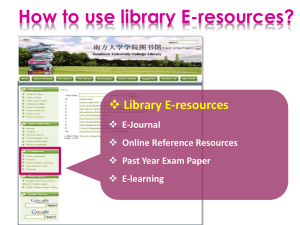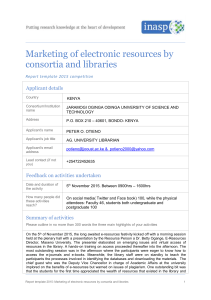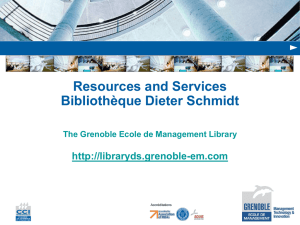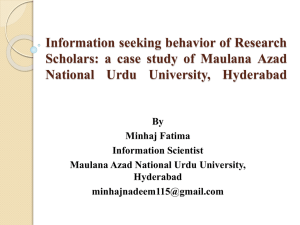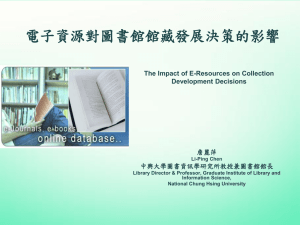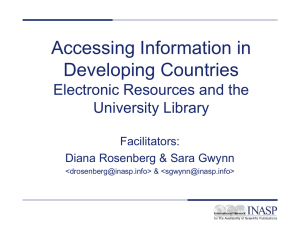Keywords: Electronic Resources, E-Resources, Academic
advertisement
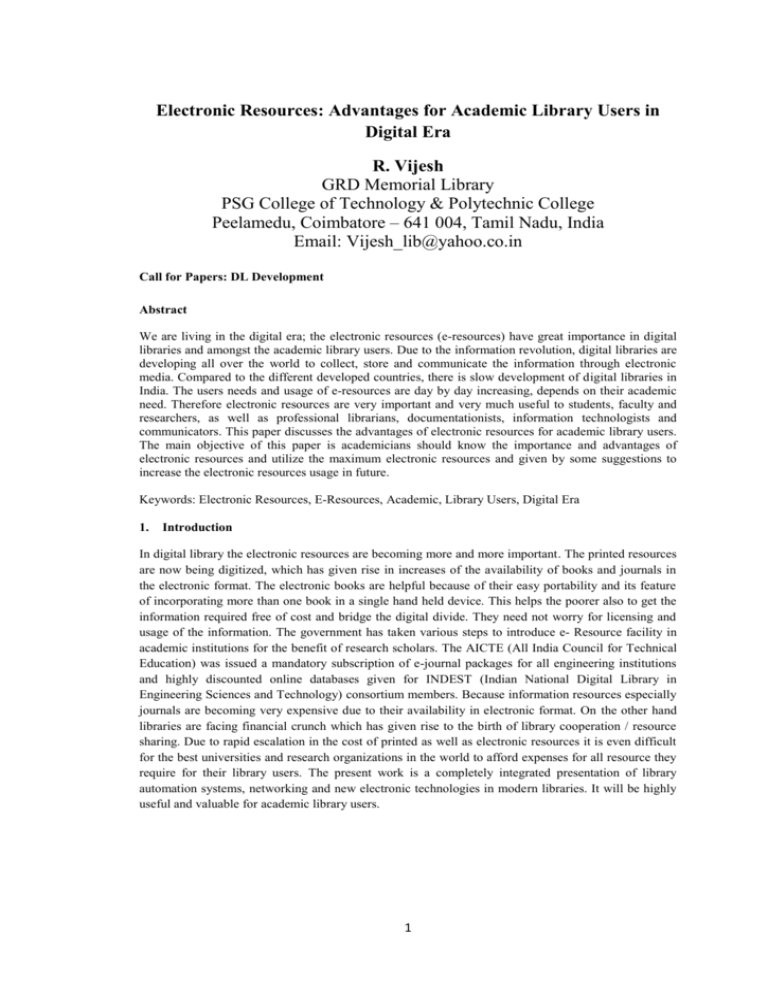
Electronic Resources: Advantages for Academic Library Users in Digital Era R. Vijesh GRD Memorial Library PSG College of Technology & Polytechnic College Peelamedu, Coimbatore – 641 004, Tamil Nadu, India Email: Vijesh_lib@yahoo.co.in Call for Papers: DL Development Abstract We are living in the digital era; the electronic resources (e-resources) have great importance in digital libraries and amongst the academic library users. Due to the information revolution, digital libraries are developing all over the world to collect, store and communicate the information through electronic media. Compared to the different developed countries, there is slow development of digital libraries in India. The users needs and usage of e-resources are day by day increasing, depends on their academic need. Therefore electronic resources are very important and very much useful to students, faculty and researchers, as well as professional librarians, documentationists, information technologists and communicators. This paper discusses the advantages of electronic resources for academic library users. The main objective of this paper is academicians should know the importance and advantages of electronic resources and utilize the maximum electronic resources and given by some suggestions to increase the electronic resources usage in future. Keywords: Electronic Resources, E-Resources, Academic, Library Users, Digital Era 1. Introduction In digital library the electronic resources are becoming more and more important. The printed resources are now being digitized, which has given rise in increases of the availability of books and journals in the electronic format. The electronic books are helpful because of their easy portability and its feature of incorporating more than one book in a single hand held device. This helps the poorer also to get the information required free of cost and bridge the digital divide. They need not worry for licensing and usage of the information. The government has taken various steps to introduce e- Resource facility in academic institutions for the benefit of research scholars. The AICTE (All India Council for Technical Education) was issued a mandatory subscription of e-journal packages for all engineering institutions and highly discounted online databases given for INDEST (Indian National Digital Library in Engineering Sciences and Technology) consortium members. Because information resources especially journals are becoming very expensive due to their availability in electronic format. On the other hand libraries are facing financial crunch which has given rise to the birth of library cooperation / resource sharing. Due to rapid escalation in the cost of printed as well as electronic resources it is even difficult for the best universities and research organizations in the world to afford expenses for all resource they require for their library users. The present work is a completely integrated presentation of library automation systems, networking and new electronic technologies in modern libraries. It will be highly useful and valuable for academic library users. 1 2. Electronic Resources in Academic Libraries E-resources are those resources which include documents in electronic or e-format that can be accessed via Internet in digital library environment. E-resources are that electronic product that delivers a collection of data, be it text, image collection, other multimedia products like numerical, graphical mode for commercially available for library and information centre’s. These may be delivered on CDROM / DVD, over the Internet and so on. Providing access to e-Resources is a service to help academic library users to find E – databases, E- journals, E-Magazines, E-Books, E-Audio, E-Images, Data, GIS, Digital Library Projects, Electronic Exhibitions, E-Subject Guide, E-newsletters, E-White papers, Econferences proceedings and Web search tools on a range of topic. Many of the electronic resources are freely available to anyone over Internet access but some are commercial resources. 2.1. Types of e-resources The academicians frequently used e-resources types are: E-journals E-books Full-text (aggregated) databases Indexing and abstracting databases Reference databases (biographies, dictionaries, directories, encyclopedias, etc.) Numeric and statistical databases E-images E-audio/visual resources 2.2. Methods of accessing e-resources/Online Databases The following methods provide access to e-journals, e-books and databases provided by the academic libraries. IP Based Access: Resources access to the specific range of IP (Internet Protocol Address). Username and Password: Using by username and password to access the resources. Free Access: Freely available electronic recourse access via the Web. 2.3. E-resources/Online Databases The academicians commonly accessed online databases/electronic resources are: Science Direct Web of Science IEEE/IEE/IEL Online J-Gate Springer INSIGHT Nature Pro Quest Science EBSCO Online ESDU Euromonitor (GMID) Wiley Blackwell Elsevier 2 ACM Digital Library AIP/APS Journals ASCE Journals Online ASME Journals Online ASTM Standards + Digital Library Capitaline Databases CRIS INFAC Industrial Information Emerald Management Xtra ICE+Thomas Telford IEC Standards McGraw- Hill’s Gale Cengage Learning RMIT OSA: Optics Infobase Wiley InterScience INSPEC on EI Village MathSciNet SciFinder Scholar SCOPUS 3. Objectives of the Study The objectives of the study are: To create the awareness of the usage of e-resources among the academic work of students, faculty and research scholars. To analysis the advantages and importants of electronic resources for academic library users. Users should get the quality of information retrieved through electronic resources. To find out the problems faced by the academic library users while accessing e-resources. To given some suggestions to increase the electronic resources usage and also improve the electronic library services to academic users. 4. Advantages of Electronic Resources The several advantages are: E - Resources user friendly interface. 24 x 7 (Any Time Information available). Library users don’t have to wait for the library to open to access them. E - Resources can be accessed by several users simultaneously. E - Resources are peer reviewed information sources. E - Resources are huge information reservoirs. E - Resources have multidisciplinary approach. Articles published in electronic journals can be updated and corrected even after publishing. Electronic journals provide advanced searching facilities. Electronic journals can provide access to articles in multiples formats and languages. Electronic journals offset the missing issue problem. Articles are displayed and printed clearly an easily to read format. 3 5. Articles can be downloaded and printed simultaneously by more than one reader, depending on access rights and permission. E - Resources save physical storage space. A single CD ROM can contain many volumes of a particular journal and thousands of full text articles with graphics. E - Resources provide quick information, up to date information, easy citations, various search options and special services like SDI (Selective Dissemination of Information), Alerts etc., E-Resources provide access to literally thousands of e-journals, e-books etc., than the library could possibly subscribe to in paper format. Some e-resources include publication subscriptions dating back the last 10 years (or more!). While we do have backdated microfilm for handful of e-journals, e-books newspapers, most magazines and newspapers are only kept for a period of months. Users can search e-resources to find articles on a particular subject from many different publications at the same time without having to search each publication separately. To users especially useful for finding information not yet available in books, or obtaining upto-date information on current events or issues. E-Resources provide us with authoritative, accurate, current, objective reference material not readily available through a search engine like Google. Users can be accessed from any computer on campus and usually any computer off campus, any time of the day or night, so there is no need to make a trip to the library Every journal can be searched quick and easy often through the complete full text of articles and via online index. An electronic resource is lot quicker to browse or search, to extract information from, and to integrate that information into other material and to cross-search or reference between different publications. E-Resource will allow the user to approach the publications to analyze its content in new ways by click of the mouse on search mode. E-Resources may include international reach, unlimited capabilities, reduced cost, convenience, search ability and linking. If a particular volume of the print version of the journals is not complete. Library staff can download and print all the articles available online or can save it in digital form till the time hardcopy is supplied by the publishers. Permission in some cases may be necessary. The e-journals get published or reach the subscribers much before their counterpart. Its also reaches all its subscribers simultaneously, where as there are many factors, mainly geographical and procedural, which case delays in case of print journals. Multiple and remote access makes it available at one’s desk. This is a boon for a huge campus where there are hundreds of readers with many departments available. E-Resources interactive rapid turnaround time means articles can be read, commented by the readers, amended quickly and greater feedback thru the web. In electronic resources hypertext format should be exploited and links to related articles, information on other web sites, stable URLs for individual articles and email alerts when latest issue loaded. An additional advantage for users using animation, virtual reality and interactive mathematical charts in web. Electronic journals do not required more timing for publishing and distributing process, therefore save the time of the users. Disadvantages The few disadvantages are: Difficulty in reading computer screens: Electronic journal is the limitations of the computer monitor, this leads to problem with reading and long reading from screen can cause eyestrain. 4 6. Less permanent: Electronic version of online journal is easy to lose and their reliance on soft wares and hard wares makes them impermanent. Higher cost: Retrieve some electronic articles need more cost. License/ Copyright issues: Issues regarding revision of the licenses and copying and distributing of resources. Suggestions The following some suggestion to increase the electronic resources usage in academic libraries. Need to increase the bandwidth so as to increase the speed of upload/download and without power cut. E-Resource access should be open in Saturdays, Sundays and other holidays. More computer terminals should be installed in the library for easy access to users. There should be made necessary arrangements for resource sharing (by using Wi-Fi Technology) with libraries. Allocate the computers for each and every online database in library, users can access the electronic resources without any interferer to their respective subjects. E-Resources users should be taught about advanced search strategies and the use of controlled vocabulary to make electronic search process much easier. IP (Internet Protocol address) based access for online databases is very help full to access the campus wide access and also secure, outsiders cannot able to access the resources. All the available online databases in library details informed by internal circular, intranet link, OPAC and institution website to users. Keep the online databases link in OPAC, users they can easily to connect the online databases website. Regarding e-resources related news send to users by phone short message and this is help to increase the library e-resources services. All the online databases news should be provided at the college website and it should be regularly updated. Information regarding the subscribed online databases and the latest available electronic resources websites and freely available resources websites also with their addresses should be displayed on the library and all department notice boards and also computer labs. Asking the vendors to supply the databases in easy formats. Many resources are still in print; in future all resources should be available in digital form. The library should be an IT trained staff in the digital library room for helping the users in case of difficulty. Digital resources should be made easy to use and easy to learn to users. The library web page should provide online guide to digital resources and various search options beyond key words to digital resources. This is help to users find the desires content at quickly and also increase the e-resources usage. The library should also identify the non-users of electronic resources and proper steps should be taken to convert them into potential users of the resources. Library users (students, faculty, and researchers) must be given orientation and user awareness training time to time for maximum utilization of e-resources. Consortia based digital information services should be strengthened by adding more resources like, journals, books, databases, theses, reports, union catalogue of all information documents available in all libraries. Library and information professionals should be given training for managing the e-resources and given services to the end users. Librarian and library staff should familiar in online databases searching techniques. 5 7. Users should know the information about the free access against the print subscription is usually available either on the journal’s cover page or on their website and some times even in the publisher’s catalogue. Also there are good numbers of e journals available free of cost. Users should identify the free access online e-resources provided by some publishers. Yearly once get back the feedback from library users, this is help to know the users need and to take decision to improve the usage of e-Resources usage in future. Conclusion Access to e- Resources (e-journals and e-books) is very much useful to both libraries and users as problems of missing issues or delay in receipt of issues can be overcome. Online resources make their appearance on the net much before the print copies reach the subscribers; therefore users get the resources at earliest and their time is saved. After implementing AICTE mandatory online subscription for engineering institutions is way to increasing the online subscription and electronic resources usage. Based on the analysis of advantages of electronic resources for academicians, Compare with advantages and disadvantages of e-resources maximum majority is more advantages for academic users and they regard them as less reliable. The academic library users facing problems while using the electronic resources maximum overcome by above mentioned suggestions and this is will be helpful to improve the digital resources usage and services for the benefit of students, faculty and research scholars in future. Electronic resources do not occupy a great deal of physical storage space, and can be accessed remotely. Electronic libraries can provide a vehicle for extending collaboration, which is at the heart of the academy, with the aim of more effective education. The increasing the electronic resources subscription bring more satisfaction to users about the library services. The library professionals and information providers should endeavor to give the right resources (e-resources) to the right user at the right time. References: 1. 2. 3. 4. 5. 6. Subhash Khode, Ajay Khode. 2003, Free Online Serials in the Area of Library and Information Science, Annals of Library and Information Studies, 50 (4): 146-152. Sharma, Chelan. 2009, Use and Impact of e-Resources at Guru Gobind Singh Indrapratha University (India): A Case Study, Electronic Journal of Academic and Special Librarianship, 10 (1): 1– 8. Halima Saida Edberongbe. 2011, The Use and Impact of Electronic Resources at the University of Lagos, Library Philosophy and Practice. Available at: http:// http://digitalcommons.unl.edu/libphilprac/ ( Accessed on 27 June, 2013) A.T. Francis. 2012, Evaluation of Use of Consortium of e-Resources in Agriculture in Context of Kerala Agricultural University, DESIDOC-Journal of Library and Information Technology, 32 (1): 38-44. Projes Roy, Shailendra Kumar, M.P. Satija. 2012, Problems in Searching Online Databases: A Case Study of Select Central University Libraries in India, DESIDOCJournal of Library and Information Technology, 32 (1): 59-63. Khaiser Nikam, Dhruva Kumar. 2013, Evaluating the Effective Use of Electronic Journals by Academia, DESIDOC-Journal of Library and Information Technology, 33 (2): 125-130. 6
